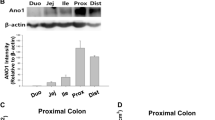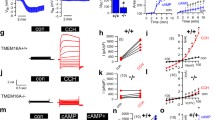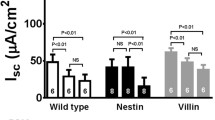Abstract
Intestinal epithelial electrolyte secretion is activated by increase in intracellular cAMP or Ca2+ and opening of apical Cl− channels. In infants and young animals, but not in adults, Ca2+-activated chloride channels may cause secretory diarrhea during rotavirus infection. While detailed knowledge exists concerning the contribution of cAMP-activated cystic fibrosis transmembrane conductance regulator (CFTR) channels, analysis of the role of Ca2+-dependent Cl− channels became possible through identification of the anoctamin (TMEM16) family of proteins. We demonstrate expression of several anoctamin paralogues in mouse small and large intestines. Using intestinal-specific mouse knockout models for anoctamin 1 (Ano1) and anoctamin 10 (Ano10) and a conventional knockout model for anoctamin 6 (Ano6), we demonstrate the role of anoctamins for Ca2+-dependent Cl− secretion induced by the muscarinic agonist carbachol (CCH). Ano1 is preferentially expressed in the ileum and large intestine, where it supports Ca2+-activated Cl− secretion. In contrast, Ano10 is essential for Ca2+-dependent Cl− secretion in jejunum, where expression of Ano1 was not detected. Although broadly expressed, Ano6 has no role in intestinal cholinergic Cl− secretion. Ano1 is located in a basolateral compartment/membrane rather than in the apical membrane, where it supports CCH-induced Ca2+ increase, while the essential and possibly only apical Cl− channel is CFTR. These results define a new role of Ano1 for intestinal Ca2+-dependent Cl− secretion and demonstrate for the first time a contribution of Ano10 to intestinal transport.







Similar content being viewed by others
References
Almaca J, Tian Y, AlDehni F, Ousingsawat J, Kongsuphol P, Rock JR, Harfe BD, Schreiber R, Kunzelmann K (2009) TMEM16 proteins produce volume regulated chloride currents that are reduced in mice lacking TMEM16A. J Biol Chem 284:28571–28578
Ball JM, Tian P, Zeng CQ, Morris AP, Estes MK (1996) Age-dependent diarrhea induced by a rotaviral nonstructural glycoprotein. Science 272:101–104
Barro Soria R, AlDehni F, Almaca J, Witzgall R, Schreiber R, Kunzelmann K (2009) ER localized bestrophin1 acts as a counter-ion channel to activate Ca2+ dependent ion channels TMEM16A and SK4. Pflugers Arch 459:485–497
Billet A, Hanrahan JW (2013) The secret life of CFTR as a calcium-activated chloride channel. J Physiol 591(21):5273–5278
Billig GM, Pál B, Fidzinski P, Jentsch TJ (2011) Ca2+−activated Cl− currents are dispensable for olfaction. Nat Neurosci 14:763–769
Caputo A, Caci E, Ferrera L, Pedemonte N, Barsanti C, Sondo E, Pfeffer U, Ravazzolo R, Zegarra-Moran O, Galietta LJ (2008) TMEM16A, a membrane protein associated with calcium-dependent chloride channel activity. Science 322:590–594
Chamova T, Florez L, Guergueltcheva V, Raycheva M, Kaneva R, Lochmuller H, Kalaydjieva L, Tournev I (2012) ANO10 c.1150_1151del is a founder mutation causing autosomal recessive cerebellar ataxia in Roma/Gypsies. J Neurol 259:906–911
Dekkers JF, Wiegerinck CL, De Jonge HR, Bronsveld I, Janssens HM, de Winter-de Groot KM, Brandsma AM, de Jong NW, Bijvelds MJ, Scholte BJ, Nieuwenhuis EE, van den Brink S, Clevers H, van der Ent CK, Middendorp S, Beekman JM (2013) A functional CFTR assay using primary cystic fibrosis intestinal organoids. Nat Med 19:939–945
Dong Y, Zeng CQ, Ball JM, Estes MK, Morris AP (1997) The rotavirus enterotoxin NSP4 mobilizes intracellular calcium in human intestinal cells by stimulating phospholipase C-mediated inositol 1,4,5- trisphosphate production. Proc Natl Acad Sci U S A 94:3960–3965
Ehlen HW, Chinenkova M, Moser M, Munter HM, Krause Y, Gross S, Brachvogel B, Wuelling M, Kornak U, Vortkamp A (2012) Inactivation of Anoctamin-6/Tmem16f, a regulator of phosphatidylserine scrambling in osteoblasts, leads to decreased mineral deposition in skeletal tissues. J Bone Miner Res 28:246–259
Elvers M, Stegner D, Hagedorn I, Kleinschnitz C, Braun A, Kuijpers ME, Boesl M, Chen Q, Heemskerk JW, Stoll G, Frohman MA, Nieswandt B (2010) Impaired alpha(IIb)beta(3) integrin activation and shear-dependent thrombus formation in mice lacking phospholipase D1. Sci Signal 3:ra1
Faria D, Schlatter E, Witzgall R, Grahammer F, Bandulik S, Schweda F, Bierer S, Rock JR, Heitzmann D, Kunzelmann K, Schreiber R (2013) The calcium activated chloride channel Anoctamin 1 contributes to the regulation of renal function. Kindey Int 85(6):1369–1381
Faria D, Schreiber R, Kunzelmann K (2009) CFTR is activated through stimulation of purinergic P2Y2 receptors. Pflugers Arch 457:1373–1380
Frizzell RA, Hanrahan JW (2012) Physiology of epithelial chloride and fluid secretion. Cold Spring Harb Perspect Med 2:a009563
Grubb S, Poulsen KA, Juul CA, Kyed T, Klausen TK, Larsen EH, Hoffmann EK (2013) TMEM16F (Anoctamin 6), an anion channel of delayed Ca2+ activation. J Gen Physiol 141:585–600
He Q, Halm ST, Zhang J, Halm DR (2011) Activation of the basolateral membrane Cl conductance essential for electrogenic K secretion suppresses electrogenic Cl secretion. Exp Physiol 96:305–316
Heemskerk JW, Bevers EM, Lindhout T (2002) Platelet activation and blood coagulation. Thromb Haemost 88:186–193
Hennig B, Schultheiss G, Kunzelmann K, Diener M (2008) Ca(2+ )-induced Cl (−) efflux at rat distal colonic epithelium. J Membr Biol 221:61–72
Hogan DL, Crombie DL, Isenberg JI, Svendsen P, Schaffalitzky de Muckadell OB, Ainsworth MA (1997) CFTR mediates cAMP- and Ca2+−activated duodenal epithelial HCO3- secretion. Am J Physiol 272:G872–G878
Juul CA, Grubb S, Poulsen KA, Kyed T, Hashem N, Lambert IH, Larsen EH, Hoffmann EK (2014) Anoctamin 6 differs from VRAC and VSOAC but is involved in apoptosis and supports volume regulation in the presence of Ca. Pflugers Arch [Epub ahead of print]
Kmit A, van Kruchten R, Ousingsawat J, Mattheij NJ, Senden-Gijsbers B, Heemskerk JW, Bevers EM, Kunzelmann K (2013) Calcium-activated and apoptotic phospholipid scrambling induced by Ano6 can occur independently of Ano6 ion currents. Cell Death Dis 4:e611
Ko EA, Jin BJ, Namkung W, Ma T, Thiagarajah JR, and Verkman AS (2013) Chloride channel inhibition by a red wine extract and a synthetic small molecule prevents rotaviral secretory diarrhoea in neonatal mice. Gut 63(7):1120–1129
Kunzelmann K, Kongsuphol P, AlDehni F, Tian Y, Ousingsawat J, Warth R, Schreiber R (2009) Bestrophin and TMEM16—Ca2+ activated Cl− channels with different functions. Cell Calcium 46:233–241
Kunzelmann K, Mall M (2002) Electrolyte transport in the colon: mechanisms and implications for disease. Physiol Rev 82:245–289
Kunzelmann K, Mehta A (2013) CFTR: a hub for kinases and cross-talk of cAMP and Ca. FEBS J 280:4417–4429
Kunzelmann K, Nilius B, Owsianik G, Schreiber R, Ousingsawat J, Sirianant L, Wanitchakool P, Bevers EM, Heemskerk JW (2013) Molecular functions of anoctamin 6 (TMEM16F): A chloride channel, cation channel or phospholipid scramblase? Pflügers Arch 466(3):407–14
Kunzelmann K, Tian Y, Martins JR, Faria D, Kongsuphol P, Ousingsawat J, Thevenod F, Roussa E, Rock JR, Schreiber R (2011) Anoctamins. Pflugers Arch 462:195–208
Kunzelmann K, Tian Y, Martins JR, Faria D, Kongsuphol P, Ousingsawat J, Wolf L, Schreiber R (2012) Cells in focus: airway epithelial cells-Functional links between CFTR and anoctamin dependent Cl(−) secretion. Int J Biochem Cell Biol 44:1897–1900
Mall M, Bleich M, Greger R, Schürlein M, Kühr J, Seydewitz HH, Brandis M, Kunzelmann K (1998) Cholinergic ion secretion in human colon requires co-activation by cAMP. Am J Physiol 275:G1274–G1281
Malvezzi M, Chalat M, Janjusevic R, Picollo A, Terashima H, Menon AK, Accardi A (2013) Ca(2+)-dependent phospholipid scrambling by a reconstituted TMEM16 ion channel. Nat Commun 4:2367
Martins JR, Faria D, Kongsuphol P, Reisch B, Schreiber R, Kunzelmann K (2011) Anoctamin 6 is an essential component of the outwardly rectifying chloride channel. Proc Natl Acad Sci U S A 108:18168–18172
Maruyama H, Morino H, Miyamoto R, Murakami N, Hamano T, Kawakami H (2013) Exome sequencing reveals a novel ANO10 mutation in a Japanese patient with autosomal recessive spinocerebellar ataxia. Clin Genet 85(3):296–7
Murek M, Kopic S, Geibel J (2010) Evidence for intestinal chloride secretion. Exp Physiol 95:471–478
Namkung W, Finkbeiner WE, Verkman AS (2010) CFTR-Adenylyl Cyclase I association is responsible for UTP activation of CFTR in well-differentiated primary human bronchial cell cultures. Mol Biol Cell 21:2639–2648
Neussert R, Muller C, Milenkovic VM, Strauss O (2010) The presence of bestrophin-1 modulates the Ca(2+) recruitment from Ca (2+) stores in the ER. Pflugers Arch 460:163–175
Ousingsawat J, Kongsuphol P, Schreiber R, Kunzelmann K (2011) CFTR and TMEM16A are separate but functionally related Cl channels. Cell Physiol Biochem 28:715–724
Ousingsawat J, Martins JR, Schreiber R, Rock JR, Harfe BD, Kunzelmann K (2009) Loss of TMEM16A causes a defect in epithelial Ca2+ dependent chloride transport. J Biol Chem 284:28698–28703
Ousingsawat J, Tian Y, AlDehni F, Roussa E, Schreiber R, Mirza M, Cook DI, Kunzelmann K (2011) Rotavirus toxin NSP4 activates the calcium dependent chloride channel TMEM16A and inhibits absorptive Na+transport. Pflugers Arch 461:579–589
Pifferi S, Dibattista M, Menini A (2009) TMEM16B induces chloride currents activated by calcium in mammalian cells. Pflugers Arch 458:1023–1038
Puntheeranurak S, Schreiber R, Spitzner M, Ousingsawat J, Krishnamra N, Kunzelmann K (2007) Control of ion transport in mouse proximal and distal colon by prolactin. Cell Physiol Biochem 19:77–88
Sailer A, Houlden H (2012) Recent advances in the genetics of cerebellar ataxias. Curr Neurol Neurosci Rep 12:227–236
Schreiber R, Kunzelmann K (2005) Purinergic P2Y6 receptors induce Ca2+ and CFTR dependent Cl− secretion in mouse trachea. Cell Physiol Biochem 16:99–108
Schreiber R, Uliyakina I, Kongsuphol P, Warth R, Mirza M, Martins JR, Kunzelmann K (2010) Expression and function of epithelial anoctamins. J Biol Chem 285:7838–7845
Schroeder BC, Cheng T, Jan YN, Jan LY (2008) Expression cloning of TMEM16A as a calcium-activated chloride channel subunit. Cell 134:1019–1029
Seidler U, Blumenstein I, Kretz A, Viellard-Baron D, Rossmann H, Colledge WH, Evans M, Ratcliff R, Gregor M (1997) A functional CFTR protein is required for mouse intestinal cAMP-, cGMP- and Ca(2+)-dependent HCO3- secretion. J Physiol 505:411–423
Shimizu T, Lehara T, Sato K, Fujii T, Sakai H, Okada Y (2013) TMEM16F is a component of a Ca2+−activated Cl− channel but not a volume-sensitive outwardly rectifying Cl− channel. Am J Physiol Cell Physiol 304:C748–C759
Stohr H, Heisig JB, Benz PM, Schoberl S, Milenkovic VM, Strauss O, Aartsen WM, Wijnholds J, Weber BH, Schulz HL (2009) TMEM16B, a novel protein with calcium-dependent chloride channel activity, associates with a presynaptic protein complex in photoreceptor terminals. J Neurosci 29:6809–6818
Strauss O, Muller C, Reichhart N, Tamm ER, Gomez NM (2014) The role of bestrophin-1 in intracellular ca(2+) signaling. Adv Exp Med Biol 801:113–119
Tian Y, Schreiber R, Kunzelmann K (2012) Anoctamins are a family of Ca2+ activated Cl− channels. J Cell Sci 125:4991–4998
Vermeer S, Hoischen A, Meijer RP, Gilissen C, Neveling K, Wieskamp N, de Brouwer A, Koenig M, Anheim M, Assoum M, Drouot N, Todorovic S, Milic-Rasic V, Lochmuller H, Stevanin G, Goizet C, David A, Durr A, Brice A, Kremer B, van de Warrenburg BP, Schijvenaars MM, Heister A, Kwint M, Arts P, van der Wijst J, Veltman J, Kamsteeg EJ, Scheffer H, Knoers N (2010) Targeted next-generation sequencing of a 12.5 Mb homozygous region reveals ANO10 mutations in patients with autosomal-recessive cerebellar ataxia. Am J Hum Genet 87:813–819
Viitanen T, Sukumaran P, Lof C, Tornquist K (2012) Functional coupling of TRPC2 cation channels and the calcium-activated anion channels in rat thyroid cells: implications for iodide homeostasis. J Cell Physiol 228(4):814–823
Watt SA, Kular G, Fleming IN, Downes CP, Lucocq JM (2002) Subcellular localization of phosphatidylinositol 4,5-bisphosphate using the pleckstrin homology domain of phospholipase C delta1. Biochem J 363(Pt.3):657–666
Wolf W, Kilic A, Schrul B, Lorenz H, Schwappach B, Seedorf M (2012) Yeast Ist2 recruits the endoplasmic reticulum to the plasma membrane and creates a ribosome-free membrane microcompartment. PLoS ONE 7:e39703
Yang H, Kim A, David T, Palmer D, Jin T, Tien J, Huang F, Cheng T, Coughlin SR, Jan YN, Jan LY (2012) TMEM16F forms a Ca(2+)-activated cation channel required for lipid scrambling in platelets during blood coagulation. Cell 151:111–122
Yang YD, Cho H, Koo JY, Tak MH, Cho Y, Shim WS, Park SP, Lee J, Lee B, Kim BM, Raouf R, Shin YK, Oh U (2008) TMEM16A confers receptor-activated calcium-dependent chloride conductance. Nature 455:1210–1215
Acknowledgments
This study was supported by DFG SFB699A7 and Wilhelm-Sander Stiftung Ano6 and Deutsche Krebshilfe Projekt 109438. We gratefully acknowledge the generous supply of the Ano6−/− mice by Prof. Dr. A. Vortkamp (Department Entwicklungsbiologie, University of Essen, Essen, Germany) and Ano-1 antibodies by Prof. Dr. Brian Harfe (University of Florida at Gainesville, Gainesville, USA).
Conflict of interest
The authors declare no conflict of interest.
Author information
Authors and Affiliations
Corresponding author
Electronic supplementary material
Below is the link to the electronic supplementary material.
Supplementary Table S1
(DOCX 15 kb)
Supplementary Fig. S1
(PDF 75 kb)
Supplementary Fig. S2
(PDF 499 kb)
Supplementary Fig. S3
(PDF 575 kb)
Supplementary Fig. S4
(PDF 107 kb)
Supplementary Fig. S5
(PDF 55 kb)
Rights and permissions
About this article
Cite this article
Schreiber, R., Faria, D., Skryabin, B.V. et al. Anoctamins support calcium-dependent chloride secretion by facilitating calcium signaling in adult mouse intestine. Pflugers Arch - Eur J Physiol 467, 1203–1213 (2015). https://doi.org/10.1007/s00424-014-1559-2
Received:
Revised:
Accepted:
Published:
Issue Date:
DOI: https://doi.org/10.1007/s00424-014-1559-2




